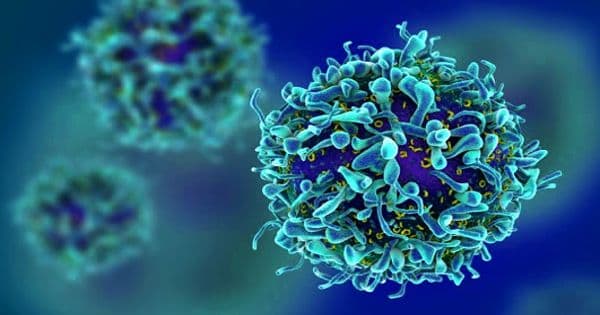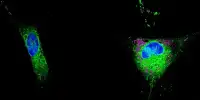Scientists works on Enzyme Power on Immune Cells
The immune system is a complex and highly developed system, yet its mission is simple: to seek and kill invaders. Contact, serendipity, and an enzyme named DOT1L have all been combined to produce some exciting results from two classes of Monash Biomedicine Discovery Institute (BDI) scientists on the B cells and T cells of the immune system. This could contribute to further research on the target for asthma and allergies, and basic work on the development of immunity itself. Two DOT1L articles by teams headed by Professor Colby Zaph and Associate Professor Kim Good-Jacobson – whose labs are next door to each other.
In this study, the researchers found that genetically eliminating DOT1L in preclinical models led to the naïve T cells all becoming type 1 cells, which meant the cells were unable to clear worm infections but were good in countering viral infections.
The shortage of immune system cells is also the basis for DiGeorge Syndrome: the excessive growth of the thymus gland decreases the production of T cells. Professor Zaph observed that the enzyme was crucial in determining how T cells – white blood cells critical for immunity against pathogens – wanted to develop into different subsets. T cells have the ability to take on a number of fates that depend on the type of infection they encounter. Type 1 T cells (Th1) are essential for clearing viral infections, while type 2 T cells (Th2) are necessary for immunity to worm parasites. Critically, dysregulated Th1 cells can cause diseases such as inflammatory bowel disease, diabetes, and arthritis, and uncontrolled Th2 cell reactions can lead to asthma and allergies.
Professor Zaph said fundamental science has started in cooperation with the Structural Genomics Consortium, a public-private organization that produces and widely distributes chemical inhibitors of enzymes. “It was a classic experiment in fishing,” he said. “We just figured we’d see what happened with the T-cell inhibitor. For all of these enzymes little has changed but the DOT1L inhibitor has actually changed the behavior of the T cells making them hyper-functional. “What we found for the first time was that this DOT1L protein was critical to T cell differentiation and T cell function activation,” he said.
The immune system keeps track of any microbe it has ever overcome in the form of white blood cells (B-and T lymphocytes) known as memory cells. In this new analysis, the researchers observed that the genetic removal of DOT1L in preclinical models resulted in naive T cells being type 1 cells, which indicated that the cells were unable to clear worm infections but were successful at combating viral infections. “DOT1L is now a potential target not only to promote type 1 immune responses to virus vaccine responses but could also be a good way to reduce type 2 response, which is good for clearing worms,” said Professor Colby.
“We have also shown that, in the absence of DOT1L, you do not develop asthma in preclinical models of lung inflammation that causes allergies, making DOT1L a good target to look at in future asthma pathway studies.” DOT1L is now in clinical trials for human patients mainly for cancer, particularly lymphoid cancers.
Dr. Sebastian Scheer was the first author of the article.
The results emphasized the fact that the same protein may have multiple effects under different circumstances, indicating that caution should be taken in clinical trials. Associate Professor Good-analysis Jacobson’s also underscored this and, like Professor Colby’s, stressed the importance of DOT1L.
“There are a number of drugs in early clinical trials targeting DOT1L for acute lymphoblastic leukemia, but little is known about how turning off DOT1L would affect the ability of B cells to develop antibodies,” she said.
Associate Professor Good-Jacobson said her team’s earlier study showed that some forms of B cells expressed DOT1L. “That finding, combined with Colby’s early work on the specific role of T cells, has given us an incentive to investigate whether it is essential for B cells,” she said.
B cells are crucial to shielding us from viral infections. Their preventive strength comes from the development of antibodies that help remove the infection and immune memory cells that act quickly to prevent disease if you are reinfected. The development of antibodies underlies the vast majority of vaccines.
A study by Associate Professor Good-team Jacobson’s has shown that DOT1L is crucial to the production of successful B cell response during infection or in response to immunization. “What we found was that if B cells didn’t have DOT1L, they could be turned on by infection, but the engine would spit out, they’d get to a certain point in forming an antibody response, but they couldn’t go any further – they’re completely shut down before a productive antibody and immune memory can be formed,” she said.
“If you’re going to use a drug that prevents DOT1L from operating, it’s very important to know what it actually governs, so it’s vital for the body to have an appropriate antibody reaction to the infection. You’re going to have trouble battling off the virus by the wayside while you’re taking these medications.”
Understanding how B cells are controlled during the early part of the immune response was important from a fundamental biological viewpoint, said Associate Professor Good-Jacobson. “Our next step is to look at the molecule itself in the formation of immunity,” she said. Associate Professor Good-team Jacobson’s will also investigate DOT1L for its role in driving oncogenic genes in a variety of B-derived cancers.















